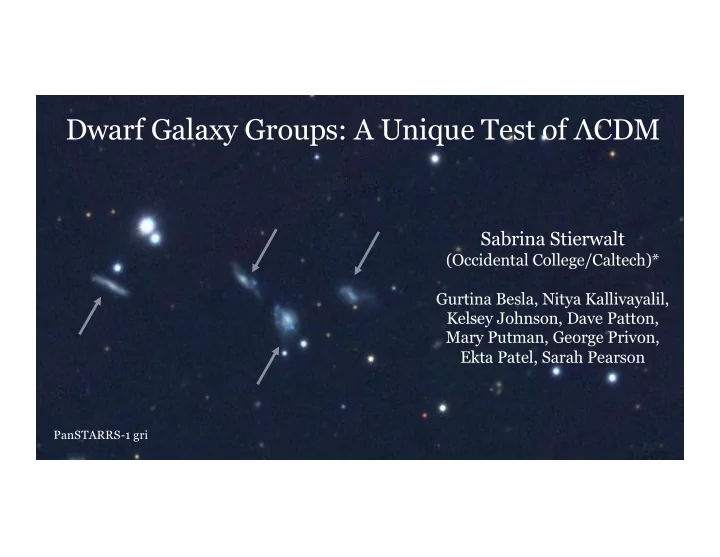

Dwarf Galaxy Groups: A Unique Test of Λ CDM Sabrina Stierwalt (Occidental College/Caltech)* Gurtina Besla, Nitya Kallivayalil, Kelsey Johnson, Dave Patton, Mary Putman, George Privon, Ekta Patel, Sarah Pearson PanSTARRS-1 gri Sabrina Stierwalt (UVa/NRAO)
Under the CDM paradigm, the sub-halo mass function is predicted to be scale-free. ! CDM predicts that dwarf galaxies should have their own satellites . Putman+02; Koposov+15 D’Onghia & Lake 08 Dooley+17b But what if we could instead determine the satellite mass function Sales, Navarro, Kallivayalil+17 in isolation … Sabrina Stierwalt (UVa/NRAO) Sabrina Stierwalt TNT Dwarf Galaxy Groups
A few examples of likely dwarf-dwarf interactions exist. BUT how representative are these examples? Besla+16 NGC4485/4490 Magellanic Clouds NGC4449 Sabrina Stierwalt (UVa/NRAO) Sabrina Stierwalt TNT Dwarf Galaxy Groups
TiNy Titans (TNT) is a systematic study of interacting dwarf galaxies. Theoretical Program: Low-z (z<0.07) Pair Sample: (lead: Gurtina Besla) (Stierwalt et al. 2015) 60 SDSS-selected Dwarf Pairs 10 7 M sun < M * < 5 x 10 9 M sun Local Volume Sample: Projected Separation < 50 kpc (lead: Mary Putman) Velocity Separation < 300 km/s D > 1.5 Mpc from a massive neighbor Sabrina Stierwalt (UVa/NRAO) Sabrina Stierwalt TNT Dwarf Galaxy Groups
TiNy Titans (TNT) is a systematic study of interacting dwarf galaxies. 1) How do galaxy mergers proceed at low mass and what does that mean for their role in the build up of more massive galaxies? 2) How do mergers affect the evolution of dwarf galaxies themselves (for example, can they explain the burstiness of dwarfs?) 3) Can we characterize the physics of star formation and feedback triggered by interactions at low metallicity, as windows to high z? TNT First Results (Stierwalt+15,+17; Besla+18) • Star formation is enhanced in paired dwarfs relative to unpaired dwarfs • Paired dwarfs do not show signs of quenching outside the presence of a massive neighbor • < 5% of dwarfs at z=0 are found in pairs • Mean number of companions per dwarf (N=0.04) agrees between SDSS & Illustris (when applying SDSS sensitivity limits) Sabrina Stierwalt (UVa/NRAO) Sabrina Stierwalt TNT Dwarf Galaxy Groups
Starting with the TNT pair sample, we look for isolated dwarf galaxy groups. Ha Group status confirmed with APO spectroscopy and the Maryland Magellan Tunable Filter Sabrina Stierwalt (UVa/NRAO) Sabrina Stierwalt TNT Dwarf Galaxy Groups
From the TNT pair sample, we identified 7 isolated galaxy groups with only low mass members. * Each group has at least 3 members (some have 4-5) with 7 < log(M * /M sun ) < 9.4 each * 2D projected sizes are: 16 – 80 kpc * 3D velocity dispersions are: 37 km/s < σ 3D < 209 km/s * Mass-to-light ratios predicted for groups to be bound groups: 12 < M tot /L B [M sun /L sun ] < 80 * Three groups have a log(M * ) ~ 9.2-9.4 dwarf and a log(M * ) ~ 8.2-8.4 dwarf Stierwalt et al. 2017, Nature Astronomy Sabrina Stierwalt (UVa/NRAO) Sabrina Stierwalt TNT Dwarf Galaxy Groups
From the TNT pair sample, we identified 7 isolated galaxy groups with only low mass members. The TNT groups were different from TNT Groups 1.5 known groups in the literature in three Tully06 Groups HCG31 Not Isolated key ways: isolation, extent, and mass. 2D Projected Size (Mpc) Annibali et al . 2016 1.0 − 0.5 − − 0.0 − − − 300 0 20 40 60 80 100 120 140 Velocity difference from group mean [km/s] 1D Velocity Dispersion (km/s) DDO 68 Sabrina Stierwalt (UVa/NRAO) Sabrina Stierwalt TNT Dwarf Galaxy Groups
At least 3 TNT isolated dwarf groups contain approximate LMC/SMC analogs with one large caveat…. M * ~ LMC M * ~ SMC Additional Companions PanSTARRS-1 gri SDSS ugriz PanSTARRS-1 gri Sabrina Stierwalt (UVa/NRAO) Sabrina Stierwalt TNT Dwarf Galaxy Groups
The systematic selection of TiNy Titans allows for direct tests of ! CDM. TNT observations match cosmological predictions to TNT M * limits Predictions from Millennium-II For dwarfs hosts with M * ~ 10 9 M sun … TNT Sales et al. Observes Predicts % with < 5% 1-3% companion of similar M * % with 0.02 < 11% 1-10% M sat /M prim < 0.4 Besla+18: mean number of companions per dwarf (N=0.04) agrees between SDSS & Illustris Sales et al. 2013 Sabrina Stierwalt (UVa/NRAO) Sabrina Stierwalt TNT Dwarf Galaxy Groups
The systematic nature of TiNy Titans allows for direct tests of ! CDM. Predictions from Millennium-II Sales et al. predicts: dwarf satellites of other dwarfs will have line of sight velocity differences of ~100 km/s TNT observes: Δ V LOS < 125 km/s for 4 groups and 200 < Δ V LOS < 300 km/s for 3 groups Sales et al. 2013 Sabrina Stierwalt (UVa/NRAO) Sabrina Stierwalt TNT Dwarf Galaxy Groups
But … Illustris suggests a contamination of 40% due to projection effects. Besla et al. 2018 Sabrina Stierwalt (UVa/NRAO) Sabrina Stierwalt TNT Dwarf Galaxy Groups
Recommend
More recommend